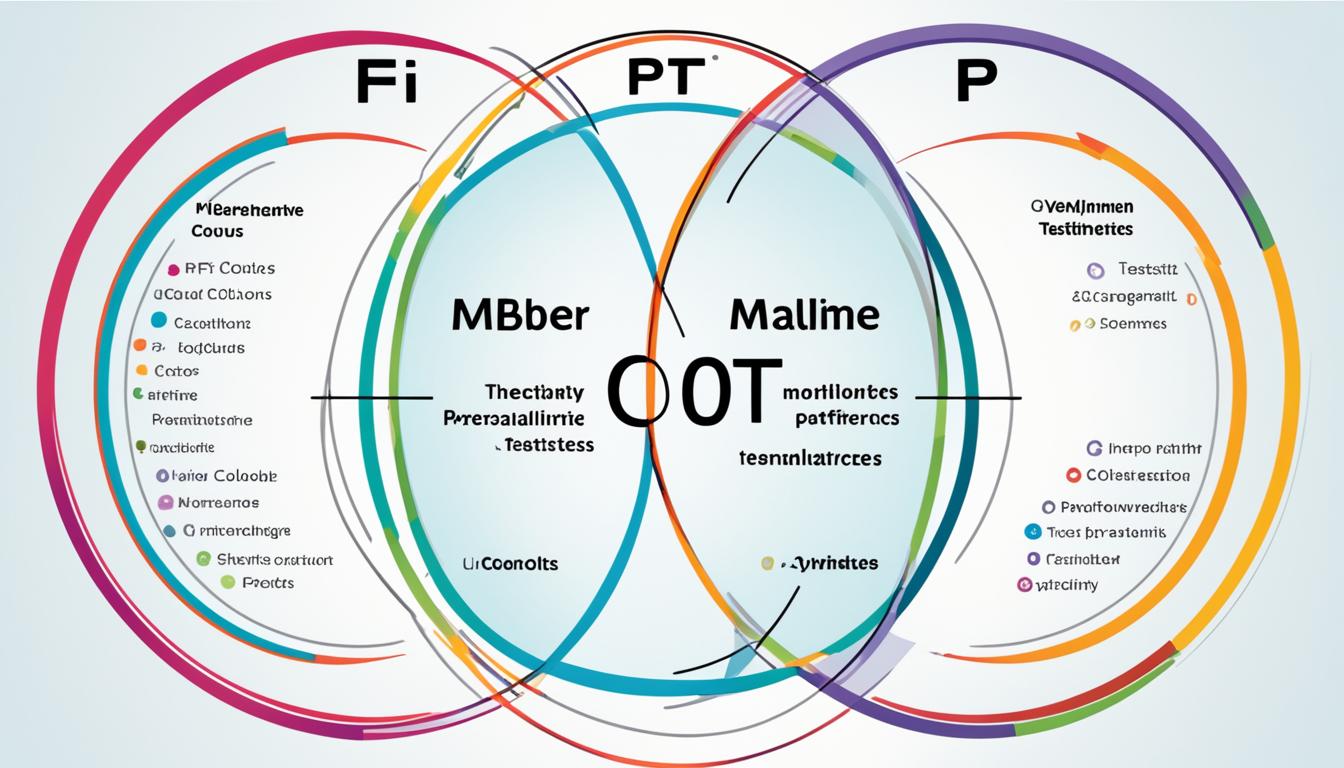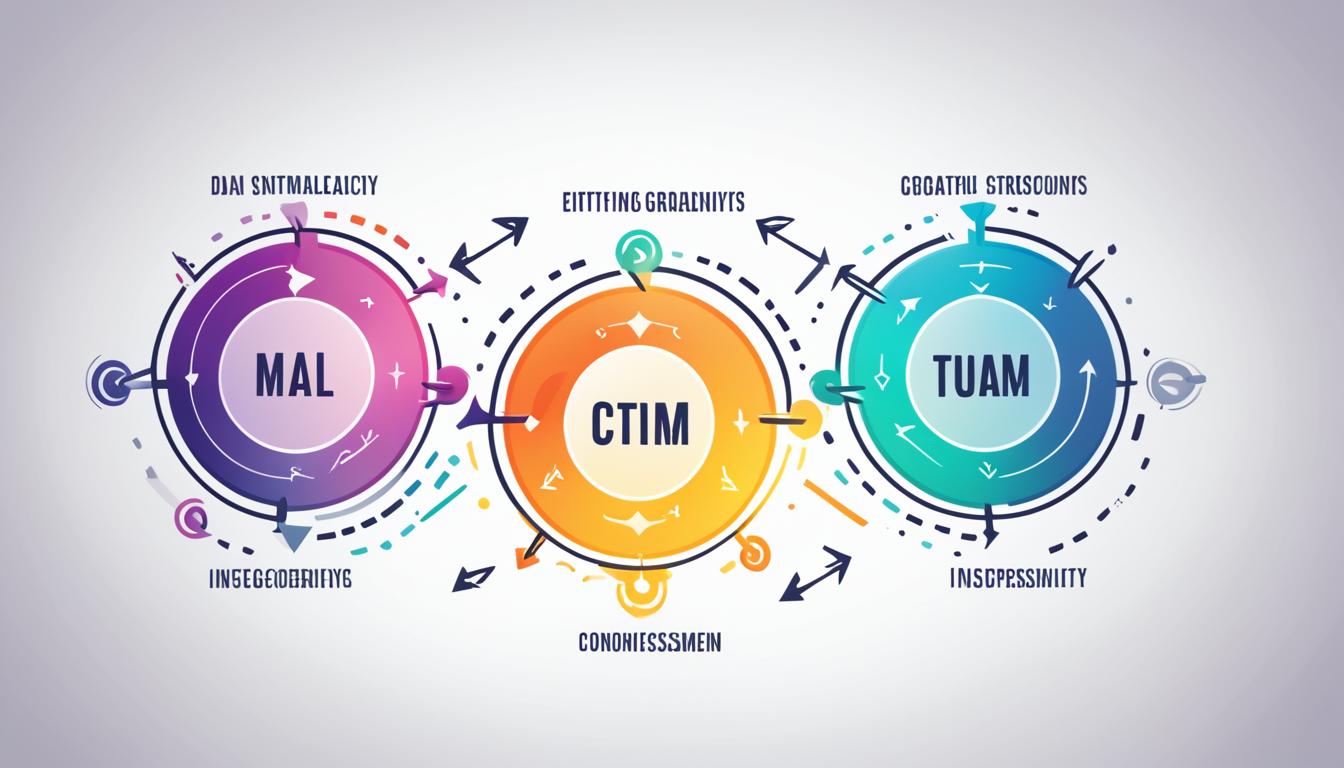Welcome to our ISTJ personality test! If you’re curious to learn more about your personality traits and how they shape your behaviors and preferences, you’ve come to the right place. The ISTJ personality type, also known as Logistician, is characterized by introversion, observance, thinking, and judging traits. ISTJs are reserved but willful individuals who approach life with a rational outlook.
By taking this personality test, you can gain valuable insights into your strengths, weaknesses, and potential areas for development as an ISTJ. Understanding your personality type can help you make informed decisions, improve your relationships, and thrive in your career.
Key Takeaways:
- ISTJs are reserved individuals with a rational outlook on life.
- They value structure, tradition, and clear hierarchies.
- ISTJs are known for their reliability, practicality, and ability to stay grounded in stressful situations.
- They have specific strengths, such as being dependable, systematic, traditional, and decisive.
- ISTJs excel in careers that involve clear goals, realistic deadlines, and the use of factual data.
Who is the ISTJ personality type?
The ISTJ personality type, also known as Logistician, possesses unique traits that differentiate them from others. With a combination of introversion, observance, thinking, and judging, ISTJs are reserved individuals who approach life with a rational outlook. They meticulously analyze situations and carry out their actions with methodical purpose.
ISTJs have a deep respect for structure, tradition, and hierarchies. They are often drawn to organizations and educational settings that provide clear expectations. Their reliability, practicality, and ability to stay grounded in stressful situations earn them respect from others. ISTJs value honesty, responsibility, and straightforward communication, believing in doing things the right way. With their strong work ethic and sense of duty, they often go above and beyond to meet their obligations.
To summarize, ISTJs are reserved yet willful individuals who value structure, tradition, and honesty. Their reliability, practicality, and grounded nature make them highly respected. They are hardworking individuals who believe in doing things the right way, often going above and beyond to fulfill their responsibilities.
ISTJ Personality Type Traits:
- Introversion
- Observance
- Thinking
- Judging
Capturing the essence of the ISTJ personality type, these traits shape their behavior, outlook, and approach to various aspects of life.
Strengths of ISTJs
ISTJs have several strengths that make them dependable and invaluable contributors in various areas. Let’s explore these notable strengths that set ISTJs apart:
1. Dependable and Systematic
ISTJs are known for their dependability and systematic approach to tasks. They thrive in working environments that provide clear systems and processes. With their strong sense of responsibility and commitment to completing tasks, ISTJs can be relied upon to deliver results consistently.
2. Task-Oriented
ISTJs are highly task-oriented individuals. They are focused on efficiently and effectively completing tasks with precision and accuracy. Their ability to prioritize and stay organized helps them meet deadlines and accomplish their goals.
3. Traditional and Upholders of Established Practices
ISTJs are often seen as traditional individuals who value and uphold established practices and structures. They have a deep respect for tradition and believe in maintaining stability by adhering to proven methods. ISTJs bring a sense of structure and order to the teams and organizations they are a part of.
4. Decisive and Practical
ISTJs are decisive individuals who make decisions based on logical reasoning and practicality. They consider facts and evidence before reaching conclusions. Their ability to analyze situations objectively allows them to make well-informed decisions quickly and effectively.
These strengths contribute to the dependability, stability, and success of ISTJs, making them valuable assets in various personal and professional settings.

Quotes:
“ISTJs bring stability and structure to any team. Their dependability is unmatched, and they ensure that tasks are completed efficiently and accurately.”
“ISTJs possess a strong sense of tradition and make sure our organization upholds our core values and established practices. Their attention to detail keeps everything running smoothly.”
ISTJ Careers
As individuals with ISTJ traits, we have unique career preferences that align with our strengths and abilities. We thrive in work environments that provide clear goals and realistic deadlines, allowing us to utilize our problem-solving skills and attention to detail. Our preference for factual data helps us excel in positions that require a logical approach and a keen eye for accuracy.
Many attractive career paths are available to us, offering opportunities for growth and fulfillment. Some of the most suitable occupations for ISTJs include:
- Management positions: We possess natural leadership qualities, enabling us to effectively organize, direct, and motivate teams.
- Administrative roles: Our organizational skills and attention to detail make us well-suited for administrative tasks, ensuring that operations run smoothly.
- Law enforcement: Our sense of responsibility and dedication to upholding rules and regulations make careers in law enforcement meaningful and fulfilling.
- Accounting: Our preference for clear expectations and structured processes aligns perfectly with the meticulous nature of accounting.
These career paths provide us with the structure we crave and allow us to play to our strengths. They also offer opportunities for advancement and professional development, ensuring a fulfilling and rewarding career journey.

Realistic Deadlines and Clear Goals
“I appreciate a work environment with clear goals and realistic deadlines. It allows me to focus on my tasks and ensures that I can deliver high-quality work within the given timeframe.”
– ISTJ Professional
Organizational Skills in Administrative Positions
“Administrative roles are a perfect fit for my ISTJ personality. I love organizing tasks, managing schedules, and ensuring that everything is running smoothly. It gives me a sense of accomplishment and satisfaction.”
– ISTJ Administrator
Management Positions and Team Leadership
“Being in a management position allows me to lead and inspire others. As an ISTJ, I bring structure, reliability, and a strong work ethic to the team, ensuring that everyone is aligned and working towards a common goal.”
– ISTJ Manager
Accuracy and Attention to Detail in Accounting
“As an ISTJ, I enjoy working with numbers and ensuring their accuracy. Accounting is a perfect career choice for me because it requires attention to detail, logical thinking, and a strong sense of responsibility.”
– ISTJ Accountant
ISTJ Relationships
In relationships, ISTJs value traditions, consistency, and loyalty. We prioritize fulfilling our commitments and work hard to maintain strong and stable relationships.
We may not express our emotions readily, but we show our dedication through our actions. Reliability, honesty, and open communication are highly valued in our relationships.
ISTJs appreciate partners who share our values and are committed to maintaining stability and security. Our consistent and loyal nature fosters trust, creating a solid foundation for long-lasting connections.
Values of Traditions and Commitments
ISTJs place great importance on traditions and a sense of continuity in a relationship. We appreciate shared rituals, customs, and values that strengthen the bond between partners.
ISTJs strive to create a stable and secure environment for ourselves and our loved ones. We find comfort in the familiarity of established traditions and are dedicated to upholding them.
Moreover, fulfilling commitments is crucial to ISTJs. We take our promises seriously and prioritize meeting our obligations. This consistency and dependability contribute to the resilience of our relationships.
Honesty and Open Communication
ISTJs value honesty and direct communication. We appreciate partners who are transparent about their thoughts and feelings, enabling us to build trust and understanding.
Open and honest conversations allow ISTJs to address any concerns or conflicts in a straightforward manner, fostering deeper connections and resolving issues efficiently.
ISTJs rely on clear communication to ensure that both partners are on the same page and have a shared understanding of each other’s needs and expectations.
Visualized Data: ISTJ Relationship Characteristics
| ISTJ Relationship Characteristics | Description |
|---|---|
| Values | Traditions, consistency, loyalty |
| Communication Style | Honest, straightforward, explicit |
| Expressing Emotions | Actions speak louder than words |
| Commitment | Fulfilling obligations and promises |
| Preference | Reliable, stable, and secure relationships |

ISTJ Overview
As we explore the ISTJ personality type, let’s delve into the characteristics that define these individuals. ISTJs have a combination of personality preferences that make them introverted, sensing, thinking, and judging individuals.
ISTJs are energized by quiet, independent work and enjoy engaging in pragmatic and detail-oriented approaches. They find order, predictability, and routine to be of great value, as it provides them with a sense of security in knowing their place in the world.
Hard workers at heart, ISTJs prioritize reliability, productivity, and persistence in all aspects of their lives. They take pride in their ability to consistently deliver high-quality work and meet their commitments.
While ISTJs appreciate the importance of teamwork, they can sometimes struggle with change and adaptability. This can make them appear stubborn at times, but it stems from a strong desire for stability and a preference for established routines.
Overall, ISTJs are individuals who thrive when there is order, routine, and structure in their lives. They find comfort in the familiar and are motivated by the security that comes with having a clear plan and organized environment. Let’s explore the world of the ISTJ personality type further and discover their unique strengths, career preferences, and strategies for personal growth.

Potential development areas for ISTJs
As ISTJs, we have many strengths that contribute to our reliability and practicality. However, there are also potential areas for development that we should be aware of in order to foster personal growth and more meaningful interactions with others.
One development area for ISTJs is our tendency to become set in our ways. Due to our preference for structure and routine, we may resist change and find it challenging to adapt to new perspectives or approaches. This rigidity can sometimes lead others to perceive us as inflexible or closed-minded.
Another area for development is our inclination towards impersonality. As ISTJs, we prioritize logic and practicality, which can sometimes overshadow our ability to connect with others on an emotional level. This can make it difficult for us to establish deep and personal relationships.
To address these development areas, it is important for us to cultivate flexibility and adaptability. By embracing change and being open to new ideas, we can broaden our perspectives and enhance our problem-solving skills. Developing empathy and actively seeking to understand others can also help us foster more meaningful connections.
Quotes:
“The only way to make sense out of change is to plunge into it, move with it, and join the dance.” – Alan Watts
By proactively working on these areas, we can expand our personal growth and become more well-rounded individuals. It is essential for us as ISTJs to recognize and address these potential development areas in order to enhance our interactions with others and create a more fulfilling life.

| Development Areas for ISTJs | Strategies for Development |
|---|---|
| Resistance to change and rigidity |
|
| Impersonality and difficulty establishing emotional connections |
|
ISTJ and Stress
ISTJs have their own set of stress triggers that can significantly impact their overall well-being. When faced with situations or individuals that challenge their preference for structure and logic, ISTJs can experience heightened levels of stress. These triggers can disrupt their sense of order and stability, leading to feelings of unease and discomfort.
For ISTJs, challenging situations that require flexibility, spontaneity, or open-ended decision-making can be particularly stressful. They prefer clear guidelines and well-defined processes, so when confronted with ambiguous or unpredictable circumstances, it can be overwhelming. Similarly, interactions with people who do not adhere to logical reasoning or challenge their logical conclusions can cause stress and frustration.
In extreme circumstances, ISTJs may exhibit signs of stress by becoming accusatory and pessimistic. They may withdraw from social interactions and shut down emotionally as a means of self-preservation. Rather than tackling the source of stress head-on, ISTJs might retreat into themselves, becoming less communicative and distant.
Recognizing and managing these stress triggers is essential for ISTJs to maintain a healthy mental and emotional state. By understanding their own boundaries and areas of vulnerability, they can proactively seek out strategies to cope with stress. This might include setting clear boundaries in their personal and professional lives, seeking support from trusted confidants or professionals, and engaging in activities that help them relax and recharge.
Managing ISTJ Stress
Here are a few strategies that can help ISTJs manage their stress effectively:
- Setting Boundaries: Recognize your limits and establish clear boundaries to ensure you have time for self-care and relaxation.
- Seeking Support: Reach out to trusted friends, family, or professionals who can provide guidance and a listening ear during stressful times.
- Engaging in Relaxing Activities: Find activities that help you unwind and recharge, such as practicing mindfulness, engaging in hobbies, or spending time in nature.
- Practicing Healthy Habits: Maintain a balanced lifestyle by getting enough sleep, eating nutritious meals, and exercising regularly.
- Utilizing Problem-Solving Skills: Approach stressful situations with a logical mindset and utilize your problem-solving skills to find effective solutions.
Remember, managing stress is crucial for ISTJs to maintain their well-being and continue functioning at their best. By recognizing their stress triggers and implementing healthy coping mechanisms, ISTJs can navigate challenging situations with resilience and maintain a sense of balance in their lives.

| Common ISTJ Stress Triggers | Impact on ISTJs | Effective Stress Management Strategies |
|---|---|---|
| Challenging structure and logic | Heightened stress levels, feelings of frustration and unease | Setting clear boundaries, seeking support, engaging in relaxing activities |
| Ambiguous or unpredictable circumstances | Overwhelm, increased stress levels | Utilizing problem-solving skills, seeking clarity, practicing mindfulness |
| Interactions with illogical individuals | Frustration, difficulty in communication | Remaining calm, seeking compromise, focusing on logical reasoning |
| Feeling overwhelmed by responsibilities | Exhaustion, burnout | Delegating tasks, prioritizing self-care, practicing time management |
ISTJ Personal Development
To achieve personal growth and development, ISTJs can find a delicate balance between their inherent need for structure and their willingness to embrace new experiences. By prioritizing flexibility, open-mindedness, and adaptability, ISTJs can navigate change more effectively and broaden their horizons.
“True personal development comes from stepping out of our comfort zones and challenging ourselves to explore new possibilities,” says Dr. Rachel Foster, a renowned psychologist specializing in personality development. “ISTJs have a natural inclination towards stability and routine, but integrating new experiences into their lives can provide invaluable opportunities for self-improvement and growth.”
Developing flexibility involves actively seeking opportunities to engage with different ideas, perspectives, and approaches. By recognizing the value of diverse viewpoints, ISTJs expand their knowledge and become more open to change.
Self-Reflection and Goal Setting
Self-reflection is a crucial component of personal development for ISTJs. Taking the time to introspect allows them to understand their thoughts, emotions, and motivations more deeply.
Dr. Foster advises ISTJs to establish a regular self-reflection practice. “By journaling or meditating, ISTJs can gain clarity about their desires, strengths, and areas for improvement,” she explains. “This self-awareness forms the foundation for setting meaningful goals.”
Setting goals is an effective strategy for ISTJs because it aligns with their natural preference for structure and achievement. By setting specific and measurable objectives, ISTJs can channel their focus and determination towards personal growth.
Improving Communication Skills
Enhanced communication skills are a valuable asset for ISTJs as they navigate personal and professional relationships. Developing the ability to express emotions and needs more readily can foster understanding and deepen connections.
Dr. Foster suggests practicing active listening and empathy to strengthen communication skills. “Listening attentively and seeking to understand others’ perspectives builds trust and rapport,” she advises. “By showing empathy, ISTJs can create a comfortable space for open and honest dialogue.”
Seeking Feedback and Continuous Learning
ISTJs can embrace personal growth by actively seeking feedback from trusted sources. Constructive critique provides valuable insights and opportunities for improvement.
In addition to seeking feedback, ISTJs should proactively pursue opportunities for continuous learning. Whether through professional development courses, workshops, or reading relevant literature, seeking new knowledge and skills enhances personal and professional growth.
| Personal Development Tips for ISTJs | Description |
|---|---|
| Embrace new experiences | Step out of your comfort zone and explore unfamiliar territories to broaden your perspective. |
| Practice flexibility | Be open to different ideas and approaches, embracing the possibility of change. |
| Cultivate self-reflection | Engage in regular self-reflection to gain clarity about your desires, strengths, and areas for improvement. |
| Set meaningful goals | Establish specific and measurable objectives to provide direction and motivation for personal growth. |
| Enhance communication skills | Practice active listening, empathy, and assertiveness to express yourself effectively and foster meaningful relationships. |
| Seek feedback | Actively seek feedback from trusted sources to gain valuable insights and opportunities for improvement. |
| Pursue continuous learning | Engage in lifelong learning through professional development courses, workshops, and relevant reading. |
“Personal development is not a destination; it’s a lifelong journey,”
reminds Dr. Foster.
“By embracing personal growth, ISTJs can cultivate a balanced and fulfilling life that honors their need for structure while promoting self-improvement and continued growth.”
ISTJ and Career Satisfaction
At its core, career satisfaction for ISTJs stems from aligning their work with their values and personal preferences. ISTJs thrive when they have clear goals, realistic deadlines, and the opportunity to work with factual data. They have a natural affinity for organized, structured environments that provide a sense of order and purpose. When ISTJs find meaning in their work and see how their contributions align with their values, their overall career satisfaction increases.
ISTJs excel in roles that allow them to utilize their analytical and problem-solving skills. They appreciate when their work involves concrete tasks and measurable outcomes. This preference for clarity and precision can be seen in their knack for delving into details and analyzing information to make informed decisions.
“Finding meaning in our work and ensuring that our contributions are valued are essential factors in our career satisfaction.”
It is important for ISTJs to feel that their work is meaningful and contributes to a larger purpose. When their work aligns with their values, ISTJs feel a sense of fulfillment and purpose in their careers. They thrive when they can see the impact of their contributions and know that they are making a difference.
Another crucial aspect of career satisfaction for ISTJs is maintaining a healthy work-life balance. ISTJs value stability and structure not just in their work but also in their personal lives. They understand the importance of setting boundaries and prioritizing self-care to prevent burnout and maintain overall well-being.

ISTJ and Personal Relationships
When it comes to personal relationships, ISTJs can greatly improve their connections by honing their communication skills and actively striving to understand their partners and loved ones. Effective communication is key, and ISTJs should prioritize maintaining open and honest lines of dialogue, allowing them to express their emotions and needs. Equally important is their willingness to listen attentively to others.
Practicing empathy and understanding is crucial for ISTJs in their relationships. By acknowledging and valuing different perspectives and approaches, they can enrich their connections with others. ISTJs should also strive to find a balance between their need for stability and their partner’s need for spontaneity or flexibility. This compromise ensures that both parties feel heard and their individual needs are met.
“Effective communication is the key to building strong and fulfilling personal relationships.”
Importance of Communication
Clear and open communication serves as the foundation for healthy relationships. ISTJs can benefit from expressing their emotions more readily and openly, as this allows their partners to better understand their thoughts and feelings. In turn, this level of vulnerability can foster greater intimacy and connection between individuals.
The Power of Understanding
Understanding is a pillar of strong relationships. By actively working to comprehend their partners’ viewpoints, experiences, and emotions, ISTJs can build deeper connections and foster a sense of trust. Recognizing and appreciating these differences creates an environment that values personal growth and mutual empathy.
Compromise for Harmony
In any relationship, compromise plays a vital role in maintaining harmony. ISTJs should strive to find a middle ground between their own need for stability and their partner’s desire for spontaneity or flexibility. This flexibility allows relationships to thrive by merging the qualities of both individuals, creating a dynamic and balanced partnership.

| Benefits of Effective Communication, Understanding, and Compromise | ISTJ Personal Relationships |
|---|---|
| Enhanced emotional connection | ✔ |
| Deeper understanding | ✔ |
| Improved problem-solving | ✔ |
| Stronger trust and intimacy | ✔ |
| Greater relationship satisfaction | ✔ |
Conclusion
The ISTJ personality test reveals valuable insights into the traits, strengths, and areas for development of individuals with this personality type. ISTJs are known for their reliability, practicality, and grounded nature. They thrive in careers that provide structure, clear expectations, and opportunities to utilize their organizational and problem-solving skills. In relationships, they prioritize loyalty and fulfilling commitments. Personal development is an important aspect of their lives, enabling them to foster growth and maintain a healthy work-life balance.
By understanding the unique traits of the ISTJ personality type, individuals can gain greater self-awareness and make informed decisions regarding their careers, relationships, and personal development. ISTJs excel in roles that require clear goals, realistic deadlines, and fact-based decision-making. They value stability, structure, and tradition, making them reliable team members and partners. Their preference for order and consistency allows them to thrive in environments where rules and procedures are well-defined. ISTJ personality traits such as a strong sense of duty, attention to detail, and practical problem-solving skills make them ideal for roles that require precision and accountability. As a result, they often gravitate toward professional paths where dependability and efficiency are highly valued.
To further their personal development, ISTJs can focus on developing flexibility, adaptability, and better communication skills. This can help them navigate change, understand different perspectives, and build stronger and more meaningful relationships. By finding a balance between their need for structure and their openness to new experiences, ISTJs can lead fulfilling lives that align with their values and bring them a sense of purpose.
FAQ
What is the ISTJ personality type?
What are the strengths of ISTJs?
What are some career options for ISTJs?
How do ISTJs approach relationships?
What are the main traits of ISTJs?
What are potential development areas for ISTJs?
What triggers stress for ISTJs?
How can ISTJs focus on personal development?
How can ISTJs find career satisfaction?
How can ISTJs enhance personal relationships?
Source Links
- https://www.16personalities.com/istj-personality
- https://eu.themyersbriggs.com/en/tools/MBTI/MBTI-personality-Types/ISTJ
- https://www.truity.com/blog/personality-type/istj
Eugene brings a fresh, dynamic voice to our platform as one of our talented Writers. Specializing in research-driven content, he explores the latest findings in psychology and personal growth, translating them into actionable insights for our readers. Eugene’s work is fueled by a curiosity about what makes us tick and a desire to help others unlock their potential.










